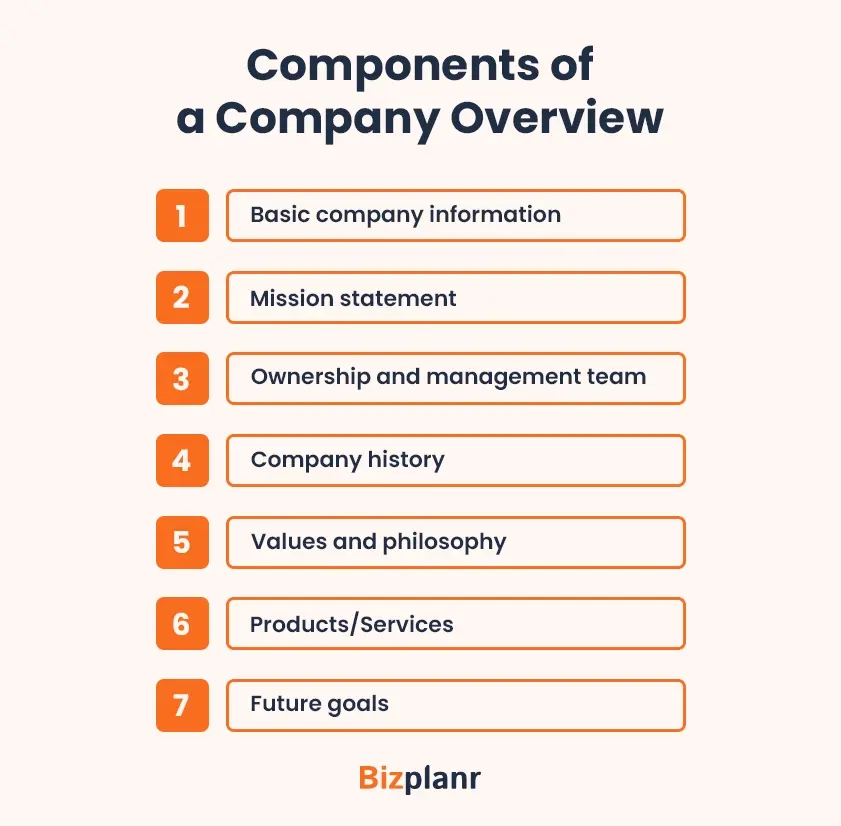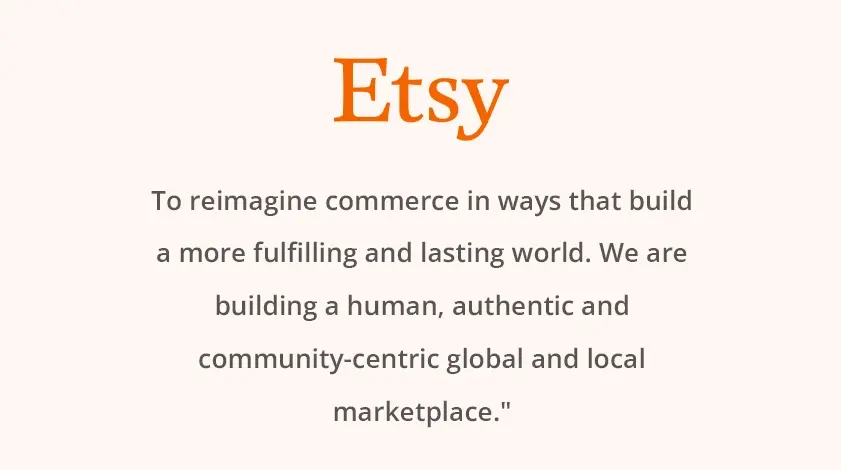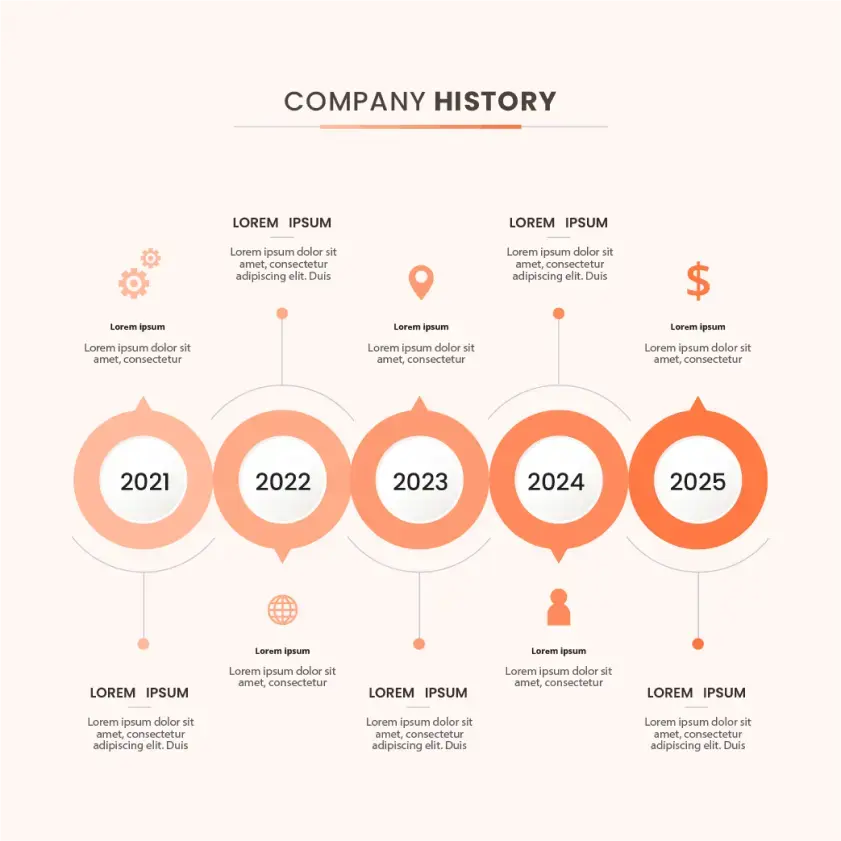What is the first thing you do when you meet someone and they tell you they’re a business owner? Check out their website! You want to know what business they do, how big they are, and the people behind it.
A company overview gives a snapshot of all this information. It forms an integral part of a company’s overall business plan and has the potential to attract potential investors and evoke their curiosity.
Now, the challenge is—how do you create one? And more importantly a captivating one.
In this article, we’ll discuss it in detail, cover the essentials of a company overview, and tips to produce a compelling overview.
What is a company overview?
A company overview is a summary of an organization providing all essential information to its readers like—the company’s background, year of establishment, purpose, mission, offerings, location, values, and goals.
It’s an essential component of a business plan. It appears right after the executive summary and is typically 1-2 pages long.
Moreover, a company overview is an excellent tool to introduce your company to new stakeholders, allowing them to understand the essence and purpose of your business. If done effectively, it can help you secure funding from investors.
Components of a company overview
While the exact components of a company overview depend on your business type and its development stage, some foundational elements make a part of every company overview.
Here are the key elements you must include while creating a company overview:
1) Basic company information
The basic information includes the fundamental details about a company, essential to understanding the company’s nature and identity. This typically includes:
- Company Name: The official name of the company registered with the government or any regulatory body when it was formed.
- Locations: Information such as a company’s headquarters and other major locations where it operates. You can also include planned locations if you’re looking to expand in the near future.
- Company Size: The total number of employees currently working in the company.
- Date of Establishment: The company’s founding year.
- Legal Structure: Whether it’s a sole proprietorship, partnership, LLC, franchise, etc.
- Other information: Phone number, email address, website URL, industry type, etc.
2) Mission statement
A mission statement refers to what a company stands for, its vision, or the purpose behind its formation. It defines your company’s core objectives and what it aspires to achieve in the long run.
To attract potential customers, you must prepare a solid mission statement. It shows that you’re not running a business just for profitability but also to have a larger vision that people can resonate with.
For example, here’s Etsy’s mission statement:
3) Ownership and management team
This section talks about who owns the company, the top management, and the key members running the company. These include Founders, CEO, COO, VP/AVP, regional managers, business heads, and other key members.
The members you want to include depend on the company size and type. That’s because every company operates on a different level and has a distinct hierarchical structure.
As far as the data goes, share basic info about your team members, such as their names and roles, along with a brief introduction about them. You can also talk about their industry-specific knowledge, accomplishments, and contributions to the company.
4) Company history
One way to create a unique personality for your business is to share your company history—how it started, its date of establishment, its origin story, and the initial idea behind its creation.
You can share the company’s timeline from the year it commenced to where it stands at present. It’s an excellent opportunity to showcase any noteworthy accomplishments and milestones achieved over the years.
You can depict this information in the form of a visual element to make it more appealing. See the below image as an example.
5) Values and philosophy
Every business organization—whether small or big—has some core values that guide its behavior and decision-making. These fundamental beliefs shape a company’s culture and define its interactions with stakeholders.
Some examples of company values are:
- Integrity
- Teamwork
- Innovation
- Adaptability
- Sustainability
- Customer satisfaction
A company’s philosophy is a statement or a set of guiding principles that drive a company’s purpose and goals. It signifies how a company approaches its business.
For example, an educational institution may run on a philosophy of – “Fostering overall development of students.”
A health-focused food brand may believe in: "Nourishing communities with healthy, accessible food for a healthier tomorrow."
6) Products/Services
A company overview is incomplete without talking about its products and offerings. This is where you briefly highlight your product, mentioning some of its key features and sharing some numbers.
The key here is to keep it brief and hold back on the details like numbers and stats for later in the specific products and services section in the business plan.
The point is to let your readers know how your product can solve customer problems or address their pain points. Share any success stories related to your product. But remember to keep it brief.
7. Future goals
If you’re targeting investors, they’re only interested in investing if your company has some concrete goals for the future.
You must decide specific, measurable targets that you aim to achieve in the short-term (e.g., in the next few quarters or within 1 or 2 years) and long-term (e.g., 3-5 years).
You can also provide insights into your expansion strategies, future innovations, growth plans, product enhancements, etc.
Doing this will make your company overview more appealing to your potential clients, and they will be more likely to invest in your company.
Tips for writing an effective company overview
Here are some quick tips:
1) Start with a compelling introduction
The first step in creating a company overview is to write a compelling introduction—also known as the elevator pitch. Explain in a few sentences what you do or sell.
The main idea here is to grab the reader’s attention. So, keep the description short, clear, and straightforward. Remember that you only have a few seconds to make an impression. So, spend some time creating the perfect pitch for your business.
A good pitch has the following qualities:
- Crisp and concise
- Easy to understand
- Generates interest and curiosity
- Sparks further conversation
2) Understand your target audience
You won’t be able to create an effective company overview if you don’t have sufficient knowledge about your target audience. It’s crucial to understand the audience type you’re catering to to create an effective company overview. If you don’t, you’ll end up wasting your resources.
Your message and tone have to be in alignment with your audience’s personality. For example, if you own a clothing brand for women, you must use language that resonates with women’s interests and carries an emotional appeal.
Understand what drives your audience. Do your homework. Know their preferences, motives, and personality traits.
A good way to study your target audience is by analyzing factors such as:
- Gender
- Age group
- Geographical location
- Income levels
3) Show your enthusiasm
You can’t sustain a business if you’re not passionate about what you do. It’s reflected in your company overview as well. To spark interest in your readers, you need to show YOUR interest first.
What makes you excited about your business, why you love what you’re doing, and how dedicated you are? Convey it in your writing. One good way to do this is through storytelling. Don’t just throw information or numbers. Have a unique brand voice that makes you memorable.
You can also use attractive infographics, charts, fancy templates, and other visually appealing elements to attract the readers and hold their attention.
4) Highlight your goals
Goals are a good indicator of a company’s direction and aspirations. They provide stakeholders and investors with a clear understanding of a company’s vision and objectives.
Goals can be of different types: financial goals, product development goals, market expansion goals, sustainability goals, and other kinds. Include them in your company overview.
Here are a few things to keep in mind while describing your goals:
- Be specific: Have clear and specific goals instead of vague ones. For example, instead of saying, “We want to grow,” say, “We aim to increase our revenue by 20% in the next fiscal year”.
- Set achievable goals: Ensure your goals are attainable and realistic. Always aim for incremental growth instead of overly ambitious goals—like making 5x or 10x revenue.
- Prioritize goals: Know which goals are most important. Classify them as primary and secondary goals and prioritize them accordingly.
5) Keep it concise
You may want to provide your readers with all the information and in-depth insights about your company. But save that for later! Include all such details in your full business plan, but keep the overview short and succinct.
A typical company overview is 1 or 2 pages long. Try not to exceed that. A clear, concise overview is more likely to hold the reader’s attention and build curiosity. It also shows that you respect your stakeholders’ time, increasing your chances to gain engagement from them.
6) Don’t forget to proofread
The final step in creating a successful company overview is proofreading it. This includes looking for any typos, misspellings, grammatical errors, or anything you may have missed.
See that you have covered all the essentials of your business. Verify all the facts and figures to ensure data accuracy. Pay attention to details. Ensure that your language has the right tone (based on the target audience) and that the text is easy to understand.
Company overview examples
Let’s explore some examples to make you familiar with how to write company overviews:
1) Nestle
Unless you were on Mars, you already know Nestle is the world’s leading brand in the food and beverage industry. Below are some excerpts from its company overview.
You can read their full company overview here.
2) Versace
Versace is an Italian luxury global fashion brand founded by Gianni Versace in 1978. Below is an example of their overview.
3) Coursera
Coursera is a US-based online learning platform and course provider. Formed in 2012, it gained a lot of popularity in recent years. Below is an excerpt from their About section.
Ready to create a captivating company overview?
Creating a company overview can seem intimidating. After all, it creates the first impression about your company in the minds of your stakeholders. (No pressure 😮💨)
But don’t worry! You can create a stellar company overview if you simply follow the tips mentioned in this article. Make sure to cover all the essential components discussed. Also, check out how other brands have written their overview to get a better idea.
Lastly, remember that a company overview is just one part of your overall business plan. You need a complete business plan to achieve your goals, and an AI business plan generator like Bizplanr.ai can help.
With an extensive collection of sample plans, a simple 3-step process, and AI assistance, it can design the perfect business plan (containing the perfect overview) for your business!
Get Your Business Plan Ready In Minutes
Answer a few questions, and AI will generate a detailed business plan.
Frequently Asked Questions
How can I make my company overview easy to understand?
Here are some tips to make your company overview easy to understand:
- Use simple language (avoid jargon and any technical terms)
- Be concise and avoid overly long, complex sentences
- Identify the tone that resonates with your target audience
Should I mention my target audience in the company overview?
Yes, it’s worth mentioning the target audience in a company overview as it:
- Clarifies the company’s focus
- Highlights its expertise
- Differentiates the company
Who should write the company overview?
A company overview should be written by someone who has good knowledge about the company and can effectively communicate the message. This could be:
- CEO/Founder or top executives - They have a deep understanding of the company and its visions, goals, and purpose.
- Marketing or communication teams - These professionals are skilled at crafting compelling narratives and brand communications.
- Copywriters – They’re specialized in creating engaging and persuasive content.
How long should a company overview be?
Generally, a company overview should be 1 or 2 pages long. Or you can say between 150-200 words. Although the ideal length depends on the company’s purpose and audience, but it shouldn’t be too long. Otherwise, it may lose the engagement.












